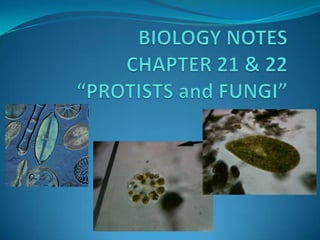
Chapter 21 and 22 notes
- 1. BIOLOGY NOTESCHAPTER 21 & 22 “PROTISTS and FUNGI”
- 2. I. Kingdom Protista Protists are eukaryotes that lack the features of animals, plants, or fungi. They can be unicellular or multicellular, autotrophic or heterotrophic. Found almost anywhere there is water and are also common in moist soil and sand.
- 3. A. Types of Protists Protozoa – heterotrophic, animal-like 1. Amoeba – moves by use of projections of streaming cytoplasm called pseudopodia (false feet). 2. Paramecium – have cilia for movement. 3. Euglena – autotrophic and heterotrophic; have an eyespot that is light sensitive. Have a flagella for movement.
- 4. Algae – autotrophic, plant-like protists 4. Can be unicellular or multicellular. Found in freshwater and saltwater. Contain chlorophyll and go through photosynthesis. Ex: large brown algae known as kelp, spirogyra,volvox Fungus-like protists 5. Slime and water molds
- 5. II. Protists and Health Some protists are beneficial: 1. Make up much of the plankton in the ocean. 2. Single largest group of photosynthesizers in the world. 3. Help recycle nutrients in the environment.
- 6. B. One of the greatest effects protists have on humans is that they cause disease in humans and livestock. 1. Malaria – spread by infected mosquitos. 2. African sleeping sickness – spread by the bite of the tsetse fly. 3. Amebic dysentery – transmitted in contaminated food or water.
- 7. II. Kingdom Fungi Fungi are heterotrophic. They obtain energy by breaking down and then absorbing organic matter through their mycelium. They are important in the environment as decomposers. Fungal cell walls contain chitin. (also found in insect exoskeletons) Fungal cells divide by mitosis. Fungi are classified into phyla based on the type of structures produced during sexualreproduction.
- 8. II. Examples of Fungi A. The common bread mold Rhizopus. B. The unicellular fungi yeasts which are important because of their ability to break down carbohydrates. Are used in the production of bread and alcoholicbeverages.
- 9. C. Includes the edible morels and truffels, and common mildews. D. The common mushroom and puffball and the fungi that cause plant diseases such as rusts and smuts.
- 10. E. The medically important fungi Penicillium which is used to make the antibiotic penicillin. F. Includes most of the fungi that cause skin diseases such as athlete’sfoot and ringworm.
- 11. III. Fungal Partnerships A. Fungi are involved in two types of symbiotic relationships with algae and plants. These are known as mutualism because each species benefits.
- 12. 1. Mycorrhizae – is a relationship between fungi and plant roots. The fungus transfers nutrients in the soil to the plant’s roots, and the plant supplies carbohydrates to the fungus. 2. Lichen is a relationship between a fungus and green algae. The fungus protects and provides nutrients. The algae provides food to the fungus.